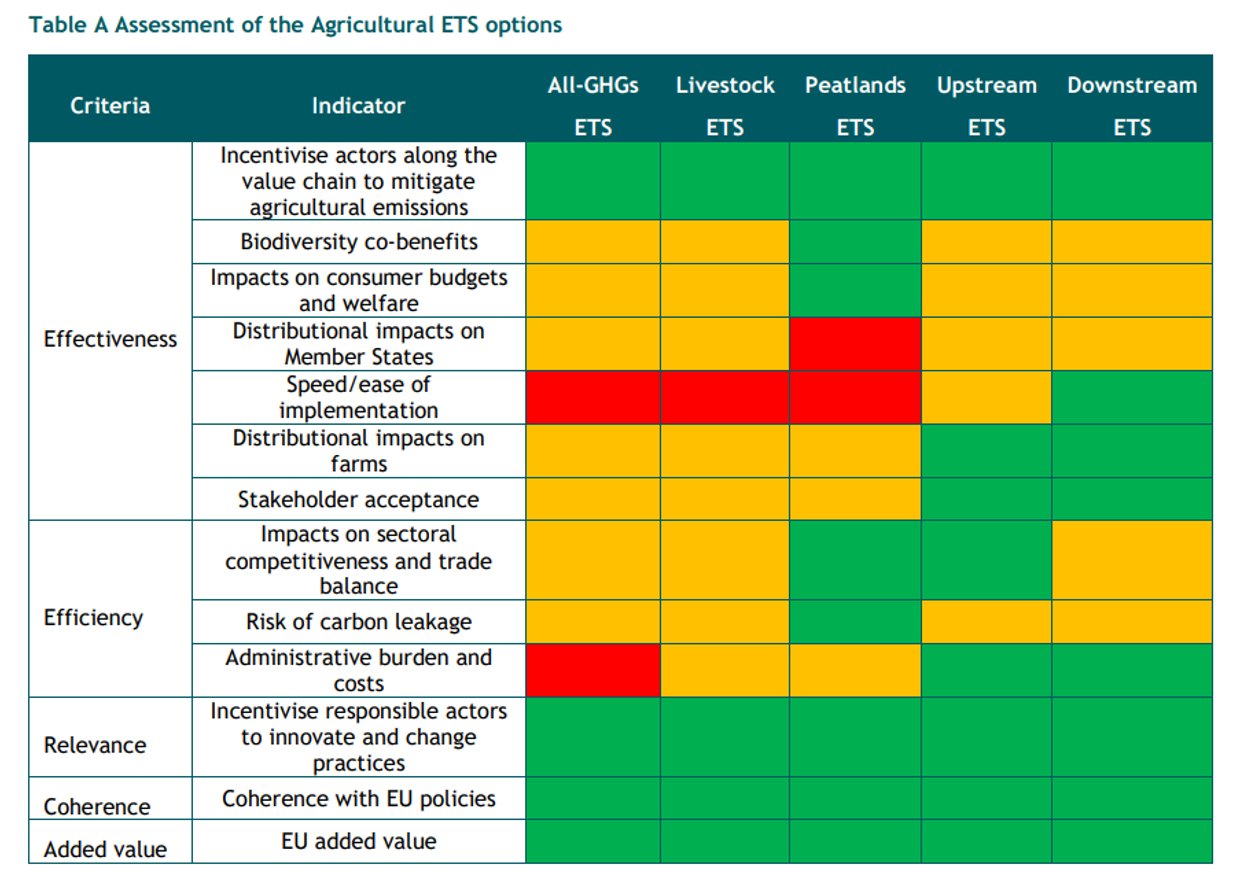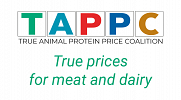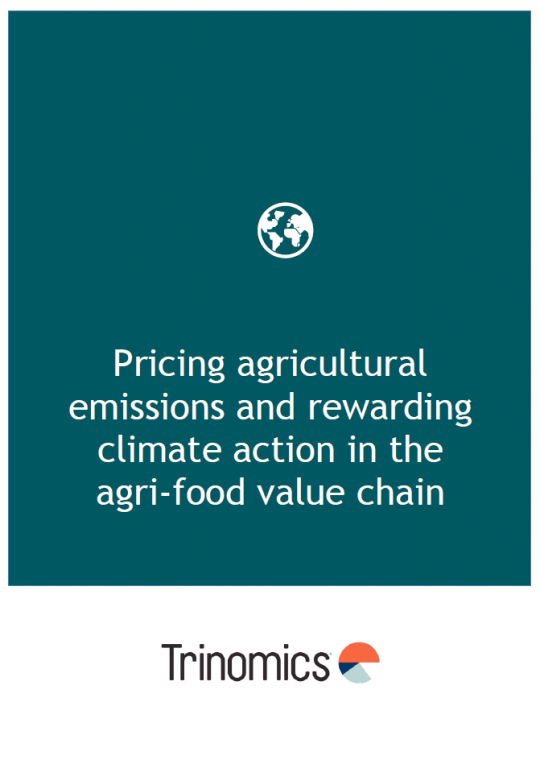New EU Commission Report on an Emission Trading System in Agriculture - Report Summary and Position
Unlocking Sustainable Agriculture: A Comprehensive Report on Emission Trading Systems in the European Union
Introduction
The Directorate-General for Climate Action in the European Union recently published a report titled: "Pricing Agricultural Emission and Rewarding Climate Action in the Agri-Food Value Chain.” This report, a follow-up to the initial findings in June, outlines a clear roadmap for implementing an Emission Tax in the EU's agricultural sector. The implications of this report are profound, shaping the trajectory of True Pricing in the food sector. In this blog I will summarise the main findings of the report, before covering the position of the True Animal Protein Price Coalition on this matter.
Current Scenario and Urgency
A staggering 13.2% of the EU27's total net greenhouse gas (GHG) emissions are directly attributed to the agricultural sector, with projections indicating a concerning stagnation. Excluding fuel use, major contributors include enteric fermentation of livestock, nitrous oxide emissions from fertilizers, and manure management in livestock production. Urgent action is required to surpass the limitations of current climate policies.
Addressing the Challenge
To meet the ambitious targets of net-zero emissions by 2050 and curbing the global mean temperature increase to 2 degrees Celsius, the report advocates for the application of the Polluter Pays Principle in Agriculture through an Emission Trading System (ETS). The report gives five main objectives for an ETS in agriculture.
Firstly, the Commission should minimise the burden of implementation and balance the costs and benefits of the ETS. Secondly, a reliable and cost-effective Measurement, Reporting, and Verification mechanism should be implemented. This would ensure the efficiency and effectivity of the system. Thirdly, safeguards should be provided against carbon leakage, which will prevent the shifting of emissions-intensive production outside the EU. Fourthly, financial incentives and support should be offered to farmers that innovate and adapt their agricultural practices. Lastly, the Commission should ensure the inclusivity and fairness of the ETS to avoid leaving any stakeholders or vulnerable social groups behind.
Versatile Emission Trading System Options
The report explores various applications of the Emission Trading System, considering quantity- or price-based approaches and hybrid options. Furthermore, the report weighs the benefits of a price being directly applied to all GHGs, or indirectly, through agricultural inputs and outputs. Lastly, the report also discusses the possibility of upstream and downstream emission trading systems.
The first option involves an On-farm ETS for all Greenhouse Gases, encompassing Land Use, Land Use Change, and Forestry net-emissions. This option is designed to be implemented across all types of farms, promoting a holistic approach to on-farm emission reduction strategies.
The second option, an On-farm ETS for Livestock Emissions, specifically focuses on mitigating enteric fermentation and managing manure. Tailored for implementation on livestock and mixed farms, this option targets key emission sources within these operations.
The third option is an On-farm ETS for Peatlands, addressing emissions from drained peatlands utilized for agricultural production. This option is particularly designed for farms built on peatland, aiming to curtail environmental impacts associated with peatland agriculture.
The fourth option, the Upstream ETS, targets emissions from enteric fermentation, nitrous oxide emissions from soils, and urea application. This option is implemented for producers and importers of fertilizers and feed, emphasizing the importance of sustainable practices in the production and supply chain.
The fifth and final option is the Downstream ETS, focusing on emissions from enteric fermentation and manure management. This option is tailored for meat and dairy processors, highlighting the need for accountability in managing emissions during the processing stage.
Collectively, these five ETS options outlined in the report present a nuanced and strategic approach to addressing emissions in agriculture, acknowledging the diverse challenges faced by the industry and offering tailored solutions for a more sustainable future.
Implementation Challenges
Implementing such an extensive Emission Trading System is not without its hurdles. With over 9 million farms in the EU, ensuring consistent adoption of GHG emission monitoring tools is a complex task. Concerns about carbon leakage, economic security for farmers, and social acceptance of the Polluter Pays Principle pose additional challenges. Most of these risks are assessed later in the report, and can also be seen below.

The Conclusions of the Report
Table A and Table B that can be found on this webpage give a clear overview of the conclusions of the Trinomics report. It first of all identifies the Downstream Emission Trading System as having the most potential for positive effects out of all the options. This conclusion is drawn after assessing the effectiveness, efficiency, relevance, coherence, and added value of the policy option. Important is to note that the impacts on consumer budgets and welfare can be more positively effected by a Downstream ETS by using its revenue to lower the VAT on fruits and vegetables. This is also one of the proposals of a recent Nature article, and would remove one of the 5 areas in which the Downstream ETS has mixed positive and negative effects.
Furthermore, from the second graph it also becomes clear that this policy is also the most popular with stakeholders. With only 10% of the stakeholders disagreeing, and over 60% supporting with the Downstream Emission Trading System.
This report is very beneficial for the implementation of an ETS, and gives a clear overview which kind of emission trading system has the preference of Trinomics, as well as the preference of the stakeholders. However, the current Commission still has delayed the plans to implement an emission trading system in agriculture until after the European Parliament elections of 2024. Until then, it is important for all stakeholders to keep pressuring the Commission and DG Clima to keep working on this crucial matter for our sustainable world.

TAPP Coalition’s Position
The TAPP Coalition Position Paper about the EU Agri-ETS was already written in June 2023 when the draft report was presented in Brussels and TAPP director Jeroom Remmers was invited to give a first comment. TAPP Coalition expects that a future ETS price for greenhouse gas emissions in livestock sectors of 80-100 euro per ton (and more) would really help to reduce emissions and help reduce the consumption of meat, dairy and eggs in Europe. The EU stakeholder survey about the draft report supports the preferred ETS option by TAPP Coalition. In total 43 percent of stakeholders prefer the ‘downstream’ ETS option for food companies to be part of the ETS system. The option that farmers or feed/fertilizer companies will be the actors under the ETS did get not much support. In total 30% of stakeholders don’t know about retail/consumers to be the actor in the ETS system. We were also happy to read other positive reactions on the proposal, for instance by Pascal Canfin, the chair of the Environmental Committee of the EU Parliament. In Politico he said “An ETS for agriculture, by contrast with the CAP, could be a "helpful tool for the transition outside the CAP”, suggesting the agricultural ETS is the best hope of bringing down the sector's emissions, that did not reduce in the last 10 years. There are rumours that Pascal Canfin has ambitions to be the next Agriculture Commissioner and the Agri-ETS could be its next priority. The IEEP also gave a positive reaction.
The True Animal Protein Price Coalition therefore supports the findings of this report, and is happily surprised by the large support among stakeholders for a downstream Emission Trading System in Agriculture. We urge the Commission to take action according to this report, and will take action in the coming months to try and make the Emission Trading System a Reality.


